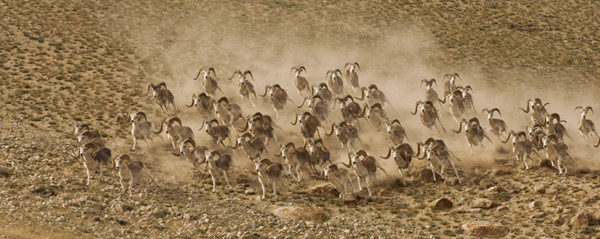Habitat is key
- By Liu Haile
 0 Comment(s)
0 Comment(s) Print
Print E-mail China Pictorial, September 4, 2013
E-mail China Pictorial, September 4, 2013
 |
|
Marco Polo Sheep (Ovis ammon polii), Taxkorgan, Xinjaing, November 2005. [Photo/Xi Zhinong/WildChinaFilm] |
CP: Currently, what species is WWF most concerned about?
Fan: Our top concerns are flagship species such as the giant panda, Siberian tiger, Amur leopard, and snow leopard. We need to allocate our limited funds to the protection of critical locations and species, and the flagship and umbrella species are even more important because of their crucial role in the balancing the entire ecosystem. Their subsistence and continuity mirror an ecosystem's completeness and health. For instance, protecting the Siberian tiger and its habitat indirectly protects many other species in the same ecosystem such as the Asiatic black bear, Eurasian elk, red deer, spotted deer, and roe deer, strengthening the entire area.
CP: What principles should we follow to protect wild animals?
Fan: First of all, we should preserve the integrity of wild habitats as much as possible. The ideal state would be vast, undivided habitats that can support population growth for 50 or even 100 years.
Secondly, we shouldn't rank specific animals because every species is crucial to the soundness and sustainability of the entire ecosystem. The state should promote the protection of every endangered species simultaneously.
Finally, we should do our utmost to maintain the subsistence of any species as long as possible, and understand that it is never too late to take action to protect them. The ultimate goal of protecting wildlife and biodiversity is to leave our own descendents the resources and opportunities to maintain the continuity of mankind.






Go to Forum >>0 Comment(s)